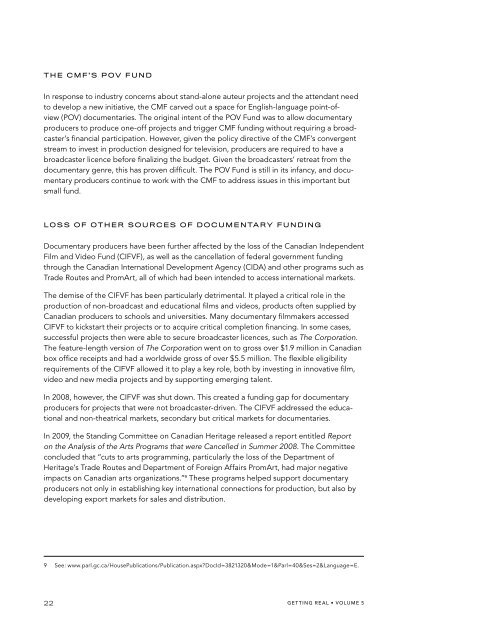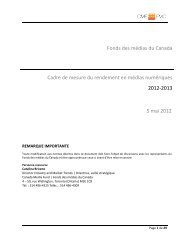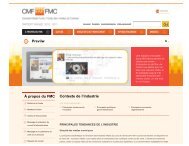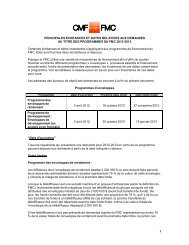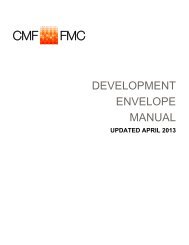Getting Real 5 - Media Development Corporation
Getting Real 5 - Media Development Corporation
Getting Real 5 - Media Development Corporation
You also want an ePaper? Increase the reach of your titles
YUMPU automatically turns print PDFs into web optimized ePapers that Google loves.
The CMF’s POV Fund<br />
In response to industry concerns about stand-alone auteur projects and the attendant need<br />
to develop a new initiative, the CMF carved out a space for English-language point-ofview<br />
(POV) documentaries. The original intent of the POV Fund was to allow documentary<br />
producers to produce one-off projects and trigger CMF funding without requiring a broadcaster’s<br />
financial participation. However, given the policy directive of the CMF’s convergent<br />
stream to invest in production designed for television, producers are required to have a<br />
broadcaster licence before finalizing the budget. Given the broadcasters’ retreat from the<br />
documentary genre, this has proven difficult. The POV Fund is still in its infancy, and documentary<br />
producers continue to work with the CMF to address issues in this important but<br />
small fund.<br />
Loss of Other Sources of Documentary Funding<br />
Documentary producers have been further affected by the loss of the Canadian Independent<br />
Film and Video Fund (CIFVF), as well as the cancellation of federal government funding<br />
through the Canadian International <strong>Development</strong> Agency (CIDA) and other programs such as<br />
Trade Routes and PromArt, all of which had been intended to access international markets.<br />
The demise of the CIFVF has been particularly detrimental. It played a critical role in the<br />
production of non-broadcast and educational films and videos, products often supplied by<br />
Canadian producers to schools and universities. Many documentary filmmakers accessed<br />
CIFVF to kickstart their projects or to acquire critical completion financing. In some cases,<br />
successful projects then were able to secure broadcaster licences, such as The <strong>Corporation</strong>.<br />
The feature-length version of The <strong>Corporation</strong> went on to gross over $1.9 million in Canadian<br />
box office receipts and had a worldwide gross of over $5.5 million. The flexible eligibility<br />
requirements of the CIFVF allowed it to play a key role, both by investing in innovative film,<br />
video and new media projects and by supporting emerging talent.<br />
In 2008, however, the CIFVF was shut down. This created a funding gap for documentary<br />
producers for projects that were not broadcaster-driven. The CIFVF addressed the educational<br />
and non-theatrical markets, secondary but critical markets for documentaries.<br />
In 2009, the Standing Committee on Canadian Heritage released a report entitled Report<br />
on the Analysis of the Arts Programs that were Cancelled in Summer 2008. The Committee<br />
concluded that “cuts to arts programming, particularly the loss of the Department of<br />
Heritage’s Trade Routes and Department of Foreign Affairs PromArt, had major negative<br />
impacts on Canadian arts organizations.” 9 These programs helped support documentary<br />
producers not only in establishing key international connections for production, but also by<br />
developing export markets for sales and distribution.<br />
9 See: www.parl.gc.ca/HousePublications/Publication.aspx?DocId=3821320&Mode=1&Parl=40&Ses=2&Language=E.<br />
22<br />
GETTING REAL • VOLUME 5


